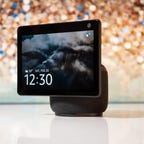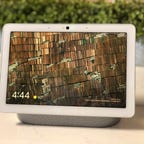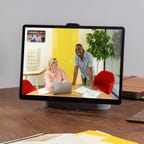 Why You Can Trust CNET
Why You Can Trust CNET Facebook Portal Plus vs. Amazon Echo Show 10 vs. Nest Hub Max
It's a three-way, smart display showdown among the biggest screens in tech -- so how do the options stack up?
Smart displays put a digital face to the voices of Google Assistant and Alexa. They come in all sizes, from tiny tabletop models to 14-inch mega displays, like the new Portal Plus Facebook just announced.
Like the Echo Show 10, the new Portal Plus comes with a camera that pans to track you around the room and keep you in frame during video calls. Google's Nest Hub Max offers a camera, too, with plenty of smart home features that make it, you guessed it, a great hub for your house.
So how do the largest models from Amazon, Google and Facebook compare? I'm so glad you asked. Let's dive in.
The Echo Show 10 stands out for a pretty simple reason: it moves. It's Amazon's sixth smart display, and the priciest of the bunch at $250 (£183, AU$345). It has cameras that track you around the room and a built-in motor that turns the display 360 degrees so it can follow you anywhere while you're video chatting or watching your favorite shows.
The Portal Plus and Nest Hub Max track you, too. But Amazon's model is the only one that actually moves. It comes with all the standard Alexa smarts you're used to, plus the option to use the display with Alexa Guard and listen for alarming sounds like a smoke detector or glass breaking. For a subscription, you can upgrade that to more sounds and monitoring.
The Echo Show 10 also features a built-in Zigbee hub that makes it easy to connect with a wide range of smart lights, smart locks and other connected gadgets. There's a physical shutter for the camera and local data processing. You can also turn off all of the camera tracking and motion features manually within settings.
The Nest Hub Max is the biggest Google screen you can buy. It's also the only Google-made smart display that has a camera (the smaller Nest Hub does not). This 10-inch model costs $229 (£168, AU$316).
Google doesn't provide that reassuring camera shutter that the Portal Plus and Echo Show 10 do. However, Google is acceptably transparent about how your data is collected, processed and stored, and you can delete that data at any time in the Home app.
There's no built-in Zigbee hub here, either. That's less and less of a problem these days, with many devices sending their signals over Bluetooth or Wi-Fi, but it's something to consider if you've already filled your smart home with gadgets that communicate using Zigbee. The Nest Hub Max won't be able to communicate with those gadgets without the help of, well, another hub.
Facebook is now on its second round of Portal Plus displays. The newest Portal Plus is a slimmed down, next-gen model. It's smarter than before, but still expensive at $350 (£257, AU$483). We haven't tested it yet, but expect to soon. In the meantime, we're using published specs to compare it with the other two, already available smart displays above.
You'll get the largest screen of this group at 14 inches. It can tilt, but lacks the motorized base of the Echo Show 10. Alexa comes built-in, but it doesn't come with a Zigbee hub or the full, on-screen functionality of a truly Alexa-centric smart display.
The Portal line, including the Portal Plus, is largely designed as a work-from-home video call machine, complete with a camera that can track you to keep you in frame while you're on a call. The Portal Plus works with several popular video-conferencing apps, including Zoom, Webex and BlueJeans (support for Microsoft Teams is set to launch this fall). The Portal experience largely relies on Facebook Watch, Messenger and Whatsapp to deliver more fun, family-oriented AR effects and video call features.
Facebook has had plenty of privacy issues in the last few years. We've been hesitant to recommend the company's devices because of it. Messages are end-to-end encrypted, but only for contacts you select. If you're specifically concerned about cameras, the Portal Plus does have a physical camera shutter and like the above displays, you can mute the mic.
Specs compared
Each smart display offers a slightly different experience. Making a decision when it comes to Google and Alexa can be tough, especially if you aren't already committed to one or the other. Sometimes seeing the specs side by side can help. How heavy is it? What music services does it support? Can I watch my favorite shows? Take a look at the specs of all three models below for a deeper comparison.
| Amazon Echo Show 10 | Facebook Portal Plus | Google Nest Hub Max | |
| Screen Size | 10.1-inch (256.5 mm) | 15.6-inch (396.2 mm) | 7-inch (177.8 mm) |
| Resolution | 720p (1,280 x 800) | 1080p (2,160 x 1,440) | 720p (1,280 x 800) |
| Dimensions (WxHxD) | 9.9 x 9.0 x 6.7 inches (251 x 230 x 172 mm) | 12.3 x 9.9 x 3.7 inches (312.8 x 250.7 x 98.0 mm) | 9.9 x 7.2 x 4.0 inches (250.1 x 182.5 x 101.2 mm) |
| Weight | 5.6 lbs. (2,560 grams) | 4.2 lbs. (1,900 grams) | 2.9 lbs. (1,320 grams) |
| Wireless connectivity | Wi-Fi (802.11b/g/n/ac, 2.4GHz and 5GHz), Bluetooth speakers requiring PIN codes not supported | Wi‑Fi (802.11a/b/g/n/ac, 2.4GHz and 5GHz), Bluetooth 4.2 | Wi-Fi (802.11b/g/n/ac, 2.4GHz and 5GHz), Bluetooth 5.0 |
| Voice assistant | Alexa | Alexa, Facebook Assistant | Google Assistant |
| Calling and messaging | Alexa Messaging, Zoom, Skype, direct dial (US and Mexico) | Facebook Messenger, WhatsApp, Blue Jeans, Zoom, Webex, Workplace, GoToMeeting | Zoom, Direct dial (US, UK, and Canada, outgoing calls only) |
| Smart kitchen features | Step-by-step recipe assistance; Amazon Meal Kits integration | Limited Alexa recipe assistance, Sidechef, Food Network | Step-by-step recipe assistance with YouTube tutorial videos |
| Onscreen smart home controls | Yes | No | Yes |
| Built-in camera | Yes (13MP) | Yes (12 MP) | Yes (6.5 MP) |
| Privacy shutter | Yes | Yes | No |
| Microphones | 4-mic array | 4-mic array | 2-mic array |
| Speakers | 2.1 system (2x 1-inch tweeters and a 3-inch woofer) | Two 5W full-range speakers, one 20W woofer | "Stereo speaker system" (2x 18mm 10W tweeters, 1 75mm 30W woofer) |
| Streaming Music Services | Amazon Music, Apple Music, iHeartRadio, Pandora, Spotify, TuneIn | iHeartRadio, Pandora, Spotify, Deezer | iHeartRadio, Pandora, Spotify, TuneIn, YouTube Music, Deezer |
| Streaming Video Services | Amazon Prime Video, DailyMotion, Netflix, Hulu, NBC, Vimeo | Facebook Watch, Food Network, SideChef | YouTube, YouTubeTV, HBONow, Crackle, The CW, Netflix |
| Compatible smart home cameras | Amazon Cloud Cam, Amcrest, August Doorbell Cam, Blink, Canary, D-Link, EzViz, Logitech Circle, meShare, Nest Cam, Netgear Arlo, Ring Video Doorbell, Toucan, TP-Link Kasa Cam, Wyze Cam, Zmodo | Amazon Cloud Cam, Amcrest, August Doorbell Cam, Blink, Canary, D-Link, EzViz, Logitech Circle, meShare, Nest Cam, Netgear Arlo, Ring Video Doorbell, Toucan, TP-Link Kasa Cam, Wyze Cam, Zmodo | D-Link, EzViz, Nest Cam, Netgear Arlo, Skybell Video Doorbell, Smartcam, Swann, TP-Link Kasa Cam, Vivitar, Wyze |
| Other notable features | Built-in Zigbee smart home hub; Integrates with Fire TV Recast to show live TV and DVR recordings; YouTube access via Silk or Firefox browsers | Automatic AI camera framing; Video chat filter effects; "Home and Away" location tracking; Facebook photo albums and birthday reminders; Interactive "Story Time" story books; 90-degree rotating display (Plus only) | "Ambient EQ" automatic adaptive screen brightness; Digital picture frame via Google Photos with Live Albums; |
| Color options | Charcoal, Glacier white | Black, white | Charcoal, Aqua, Chalk, Sand |
| Availability | US, UK, Australia, Germany, Canada, Japan | US, Canada, UK, France, Italy, Spain, Australia, New Zealand | US, UK, Australia |
| Ports | DC power port | Dc power port, USB-C | DC power port |
| Warranty | 1 year | 1 year | 1 year |
| Cost | $250 | $349 | $229 |
Different designs
We're seeing an interesting variety of designs in the smart display category, but the trend seems to be 10-inch, flat-screen-style displays that hide the bulk of the speaker in the back. That's what you get with the Echo Show 10 and its animated, moving base (that's also the speaker).
The 14-inch Portal Plus gets a lot more distinctive, with an iMac-looking raised monitor approach that rotates 90 degrees between portrait and landscape modes. It's an eye-catching smart display for sure, but after mass account breaches and scandals involving blatant mistreatment of user personal data, will people really trust Facebook enough to bring this product's camera and microphones into their homes?
Then there's Google. The Nest Hub Max now feels stuck in the middle of these two much more daring designs. It doesn't move and it doesn't have a camera shutter. It does all the things we've come to expect a smart display to do, but with far less pizzazz than the other two. That doesn't mean it's not as good. I'd argue that the streamlined experience and clean visuals of the Nest Hub Max are the easiest for a beginner just getting to know a virtual assistant.
Smart home sensibilities
Amazon and Google are each betting that you're going to want to use these smart displays to control your various smart home gadgetry. Both the Echo Show and the Nest Hub Max include dedicated, on-screen smart home controls for turning lights on and off, adjusting your thermostat and more. The Echo Show even includes a Zigbee radio that lets it pair directly with things like smart locks and Philips Hue smart bulbs, no extra hub necessary. On Google's end, the Nest Hub Max will automatically connect with Bluetooth smart bulbs from GE.
With Facebook, the focus is almost purely on those video calls. The last generation of Portals didn't have any practical smart home controls to speak of, and that made it a much harder sell as a smart display for your home. This new generation of Portals does have an Alexa interface on screen that should allow more home control. Hopefully, it's as much (or very nearly as much) as you'd get with an Echo Show device. We'll know much more about the new Portal Plus and its battery-powered sibling the Portal Go as soon as we've had a chance to test them out.
So what should I get?
The Echo Show 10 is our current pick for sheer capability and the best smart display overall. It can do the most, the motion features are truly useful once you get the hang of it, and Alexa is a well-oiled machine at this point. However, if you've got qualms about Amazon or just prefer Google Assistant, the Nest Hub Max is going to check almost all the boxes, save for that moving display part and the lack of a dedicated, onboard Zigbee radio.
Facebook? Well, that's a different story. Privacy and ethical concerns are definitely still a thing, and we haven't tested the newest Portals. We didn't recommend the last set, but improvements in Alexa and a focus on video chats could make it more palatable if you can get over the Facebook stigma. Stay tuned for full reviews of both new Portals in the coming weeks.






